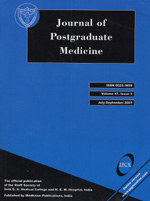
|
Journal of Postgraduate Medicine
Medknow Publications and Staff Society of Seth GS Medical College and KEM Hospital, Mumbai, India
ISSN: 0022-3859
EISSN: 0022-3859
Vol. 55, No. 2, 2009, pp. 113-120
|
 Bioline Code: jp09031
Bioline Code: jp09031
Full paper language: English
Document type: Research Article
Document available free of charge
|
|
|
Journal of Postgraduate Medicine, Vol. 55, No. 2, 2009, pp. 113-120
| en |
Prevalence and risk factors for female sexual dysfunction in women attending a medical clinic in south India
Singh, JC; Tharyan, P; Kekre, NS; Singh, G & Gopalakrishnan, G
Abstract
Background: Reports from India on the prevalence and determinants of female sexual dysfunction (FSD) are scant.
Aims: To determine the prevalence and risk factors for FSD.
Settings and Design: A cross-sectional survey in a medical outpatient clinic of a tertiary care hospital.
Materials and Methods: We administered a Tamil version of the Female Sexual Function Index (FSFI) to 149 married women. We evaluated putative risk factors for FSD. We elicited participant′s attributions for their sexual difficulties.
Statistical Analysis: We estimated the prevalence of possible FSD and sexual difficulties from published FSFI total and domain cut-off scores. We used logistic regression to identify risk factors for possible FSD. Results: FSFI total scores suggested FSD in two-thirds of the 149 women (73.2%; 95% confidence intervals [CI] 65.5% to 79.6%). FSFI domain scores suggested difficulties with desire in 77.2%; arousal in 91.3%; lubrication in 96.6%; orgasm in 86.6%, satisfaction in 81.2%, and pain in 64.4%. Age above 40 years (odds ratios [OR] 11.7; 95% CI 3.4 to 40.1) and fewer years of education (OR 1.2; 95% CI 1.0 to 1.3) were identified by logistic regression as contributory. Women attributed FSD to physical illness in participant or partner, relationship problems, and cultural taboos but none had sought professional help.
Conclusions: Sexual problems suggestive of dysfunction, as suggested by FSFI total and domain scores, are highly prevalent in the clinic setting, particularly among women above 40 and those less educated, but confirmation using locally validated cut-off scores of the FSFI is needed.
Keywords
Anorgasmia, dyspareunia, female sexual dysfunction, female sexual function index
|
| |
© Copyright 2009 Journal of Postgraduate Medicine.
Alternative site location: http://www.jpgmonline.com
|
|
